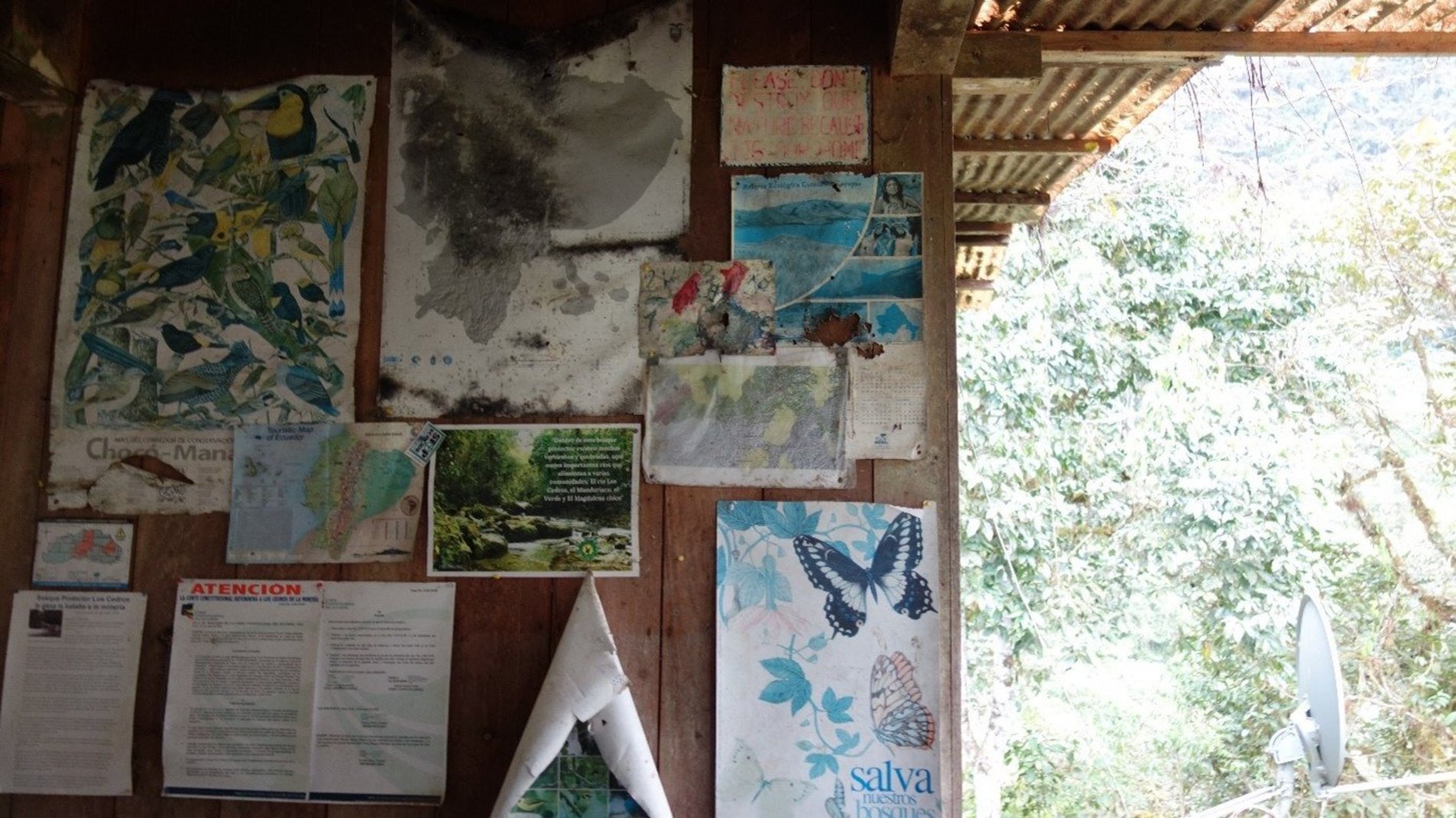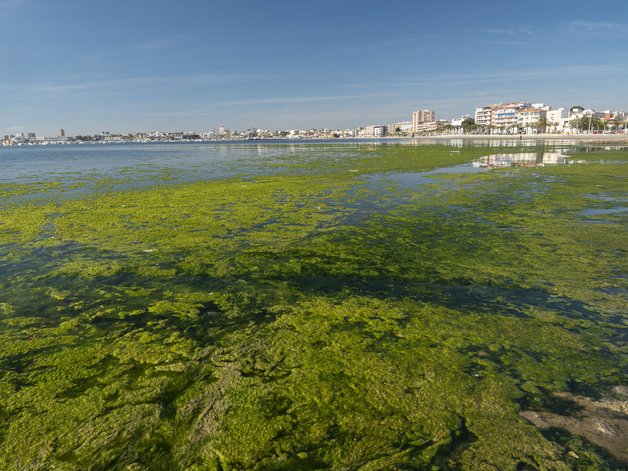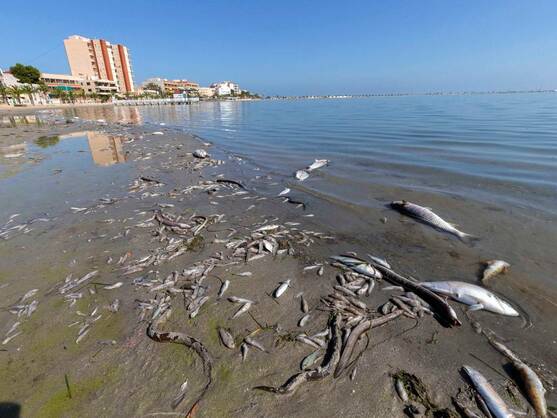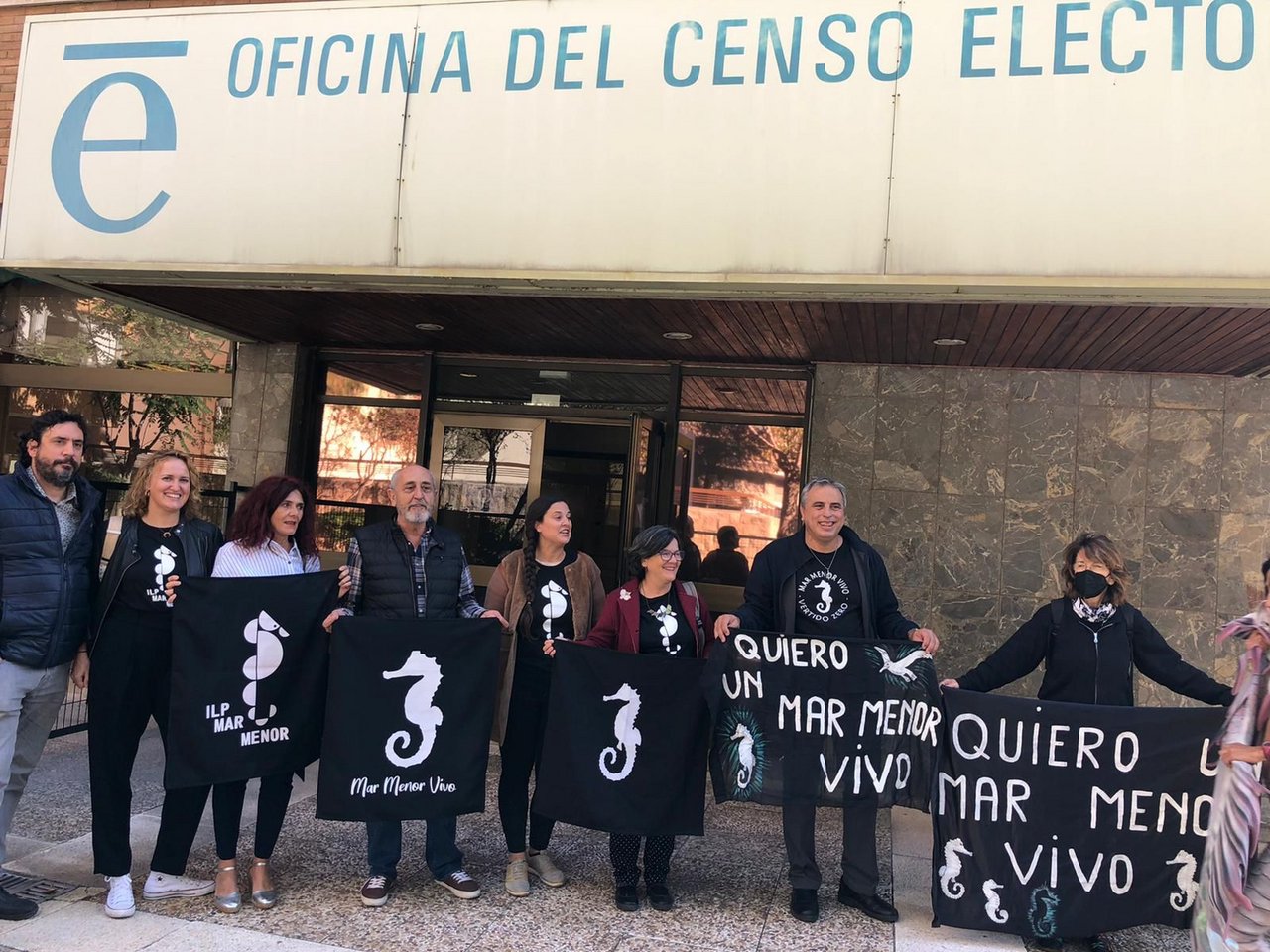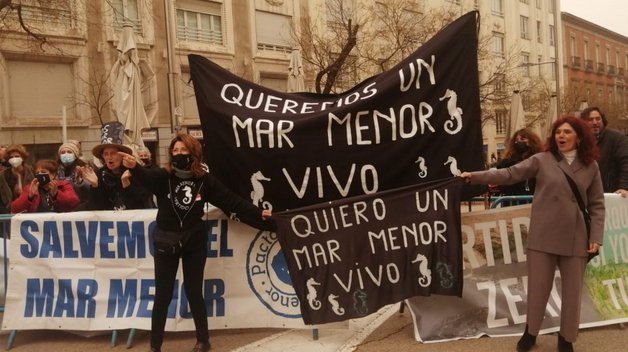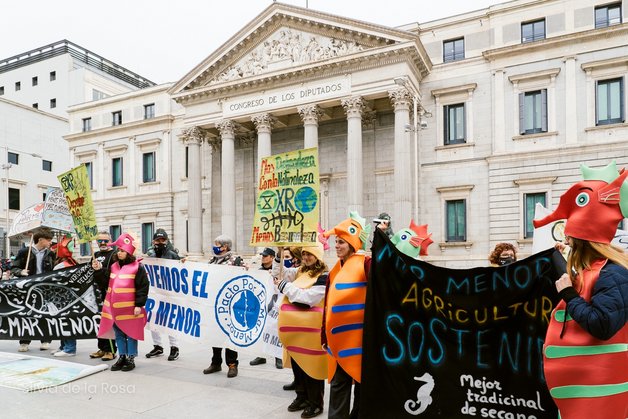Mar Menor: Europe's first ecosystem with legal 'personhood’
by Eduardo Salazar-Ortuño & Teresa Vicente-Giménez
With the recognition of the Spanish salt lagoon Mar Menor as a legal entity, the 'rights of nature' made their way into Europe in 2022 – but only after the water body had suffered profound ecological damage. Dr Eduardo Salazar-Ortuño and Prof Teresa Vicente-Giménez, legal scholars at the University of Murcia, played a key role in this process. They report on the history of this special ecosystem and its path to attaining legal subjectivity.
The Mar Menor in Eastern Spain is the largest saline coastal Mediterranean lagoon in Europe with a surface area of 135 km2 and a maximum depth of 7 metres. Within the Mar Menor there are five islands of volcanic origin. It is a marine ecosystem separated from the Mediterranean Sea by La Manga, a 22 km long sandy strip.
This relative isolation from the Mediterranean Sea, the low rainfall, and high temperatures, result in a salinity significantly higher than that of the Mediterranean Sea. In conjunction with its extreme temperatures (much higher in summer and noticeably lower in winter), the different density and salinity allowed only certain species of flora and fauna to thrive, adapting to such extreme and demanding conditions. The waters of the Mar Menor were, until relatively recently, oligotrophic, i.e. low in nutrients and primary production, with sea beds mostly bare of vegetation, making the transparency of its waters one of its most notable features.
Ecological, cultural and economic relevance
The Mar Menor has a high ecological relevance due to the habitats and species it hosts. Moreover, it is worth nothing that, as a wetland and habitat for important water birds, and as a coastal Mediterranean lagoon ecosystem - with all the complexity this entails - it has an environmental value recognised by various legal protection measures (see below).
The coastal lagoon of the Mar Menor is connected both superficially and underground with the catchment basin known as Campo de Cartagena, which is a triangular plain of 1,250 km2, located over several aquifers (underground rock layers bearing groundwater).
Therefore, the activities carried out in the catchment basin directly influence the lagoon ecosystem, which serves as a receiving basin for surface runoff from the Campo de Cartagena and for exchange of water with the aquifers.
Additionally, the Mar Menor represents a highly significant natural element of Murcia’s regional identity, not only for its environmental values, but also for its landscape, history, culture, tourism, fishery, sporting and recreational activities and as regional heritage in general. This has generated significant economic return in the tourist and small-scale fishing sectors - which more than 100 families depend upon - and underpins a strong emotional attachment of Murcia’s inhabitants and its visitors to the water body.
Historical and current environmental damages
Several human activities have profoundly altered the landscape of the Mar Menor and modified the marine flora and fauna in recent decades, following several historical causes. These include the dredging and widening of the Estacio channel, which connects the Mar Menor with the Mediterranean Sea. Moreover, it includes excessive construction in the surrounding area, seasonal population fluctuations leading to occasional discharge of wastewater, the proliferation of marinas, the creation of artificial beaches, and mining residues reaching the lagoon from the Cartagena and La Unión mountains after rainfalls. At the same time, the process of increased water exchange between the Mar Menor and the Mediterranean Sea has greatly contributed to equalising the conditions of both seas. As a result, species that had not previously been able to establish themselves in the Mar Menor began to colonise it.
In addition to the aforementioned activities, the radical transformation of agricultural uses in the Campo de Cartagena catchment area, following the promised provision of water flows from the Tagus-Segura transfer and the support of public authorities, has added another, more current cause of the degradation of the Mar Menor. This is due to the entry of chemical substances, resulting from the massive use of treatments in intensive agriculture (fertilisers, pesticides, etc.), which has almost completely replaced traditional rain-fed agriculture.
In turn, this model of intensive agriculture has transformed the topography of the region, which determined surface runoff, thus accelerating soil erosion and increasing the dragging of agricultural residues into the lagoon.
The tonnes of nitrates discharged daily into the Mar Menor have led to a disproportionate and abnormal development of phytoplankton, resulting in the darkening of the waters. This "eutrophic crisis", evidenced since the summer of 2015, has seriously damaged the balance of the natural system, to the extent that its waters have transitioned from oligotrophic (low primary production, few nutrients) to eutrophic (high primary production, many nutrients).
This has resulted in dysfunctionality of the previous self-regulating mechanisms of the Mar Menor. In 2016, the bloom of microalgae also prevented photosynthesis in the marine plants on the seabed and caused the disappearance of 85% of seagrass meadows. Likewise, in 2019 and 2021 the strong eutrophication process caused the death of tons of fish, crustaceans, and other forms of life.
This is showcasing both the unsustainable stress or collapse of the ecosystem, as well as the catastrophic damage caused.
The economic consequences of this ecological problem in the area have been colossal: according to the Bank of Spain, housing prices have fallen by 45%, i.e. a loss of 4.5 billion euros; tourism has left for other Mediterranean coasts, causing the closure of numerous businesses and resulting in job losses; the fishing sector has equally suffered. But above all, the degradation of the Mar Menor has affected the morale of the people permanently living in the area or spending holidays there. The ecological collapse of this wonderful environment that provided wellbeing and sustenance has led people to experience "solastalgia", an emotional suffering - anguish, mental or existential stress - caused by environmental deterioration.
Protective measures and environmental law
Despite the legal recognition of protective measures for this unique ecosystem since 1990 - as a protected natural space at the international (RAMSAR, ZEPIM), European (Natura 2000 Network) and regional levels (partially Regional Park, Protected Landscape), and globally as a Wildlife Protection Area – , degradation has been unstoppable.
This failure of preventive environmental law can be traced back to administrative inactivity at all levels - state, regional and local - in terms of environmental protection management, control, and inspection duties.
However it is equally linked to the preponderance of regulations that have promoted polluting urban, agricultural and livestock developments in its surroundings, the repeal of specific legislation for the lagoon (Law 3/1987, of 23rd April, on the Protection and Harmonisation of Uses of the Mar Menor), and the overall ineffectiveness of regulations within anthropocentric legal frames.
A reactive environmental law trying to attribute liability based on the "polluter pays" principle, using environmental offences, administrative sanctions, and environmental liability mechanisms, is taking too long for any final decision.
Despite specific legislative instruments being put in place for the protection and recovery of the Mar Menor (Law 3/2020, of 27 July) as a result of the mass mortality of flora and fauna, and despite plans relating to the Natura 2000 Network (Integrated Management Plan for the protected areas of the Mar Menor, Decree 259/2019, of 10 October), the citizens, who had already organised in numerous collectives in defence of the lagoon since 2016, took up the proposal put forward by the University of Murcia’s Legal Clinic of the Faculty of Law, to start a popular state legislative initiative that would recognise the legal personality of the Mar Menor and its basin, endowing it with its own rights. This proposal had already been presented to the Regional Assembly of the Autonomous Community of Murcia by means of a regional legislative initiative from the Town Council of Los Alcázares, but failed in the face of the incomprehension and excuses for lack of competence from the legal experts within the aforementioned institution.
A popular legislative initiative: The Mar Menor becomes a legal entity
The process of collecting 500,000 signatures for the Popular Legislative Initiative (PLI), as the ultimate instrument of participatory democracy enshrined in the Spanish Constitution, has been exemplary. First, a Promotional Commission registered the PLI in July 2020. After the final text was drawn up, from late October 2020, when the sealed forms were collected by the Central Electoral Board, to the moment when 639,824 signatures were delivered to the Central Office of the Electoral Board on 27th October 2021, the citizens' movement around the PLI was growing astonishingly. It was warmly received in the squares and streets of the region of Murcia and beyond, following a culmination in fish mortality in August 2021, after which the frustration had become ever more evident.
This was happening without a strong organisation, without funding and solely with the presence of volunteers who took to the streets in the midst of the COVID-19 pandemic.
And all this was achieved within the time frame established by Organic Law 3/1984, of 26th March, using one of the two extensions granted.
Once the signatures had been presented and verified, the PLI went to the Congress of Deputies, where it was defended by its promoter in the Ecological Transition Commission on 15th March 2022, following a favourable report from the Government. On 5th April, the Plenary of the Congress of Deputies took the PLI into consideration by 265 votes in favour - an unusually strong majority in this legislature and compared to the few popular legislative initiatives that had been presented. After passing the Senate, the PLI is now the precedent of Law 19/2022, of 30th September, for the recognition of the juridic personhood of the Mar Menor and its basin.
Granting legal personality to the Mar Menor and its basin involves giving it "legal capacity" and "capacity to act", as an entity within the legal system. Something that was already recognised in the 19th century for commercial entities, foundations, and associations, would now be expanded to a unique and endangered ecosystem: becoming a subject of rights. Not only does this legal institution grant rights to the Mar Menor and its basin, but it equally grants the possibility of exercising those rights, known as "legal capacity to act". Just as minors or people with special needs, who have their own rights and legal capacity and require guardians to represent and defend them, the same applies to this ecosystem.
The Mar Menor is thus the first ecosystem with rights in Europe, following a trend which has established the rights of nature in countries such as Ecuador, Bolivia, Colombia, New Zealand and Canada.
Consequences and Outlook
In September 2023, a Court in Cartagena (Murcia Region) investigating pollution offences to the coastal lagoon, called certain Administrations and non-governmental organisations to participate in the criminal investigation proceedings acting on behalf of the Mar Menor and its basin, on the basis of article 6 of the Law. Article 6 of Law 19/2022 allows any person to defend the interests of the Mar Menor and its basin before the Administrations and the Courts and to act on its behalf. Currently, five non-governmental organisations and three municipalities are participating in these proceedings and have accused three agricultural companies of polluting the lagoon, asking for compensation to restore the damage caused to the Mar Menor.
The Law granting rights to the Mar Menor is currently to be developed through a Regulation which is about to be approved by the State Government. This Regulation will detail the functioning of the institutions and mechanisms of governance of the legal person of the Mar Menor and its basin, established in Article 3 of the Law. Once the Regulation is in force, an important process of public participation will be initiated in which the competent Administrations and the members of the civil society involved will be present, through 3 Commissions: the Commission of Representatives, the Commission of Guardians and the Scientific Committee.
Eduardo Salazar Ortuño is a public interest environmental lawyer and adjunct professor in Administrative Law at the University of Murcia, Spain.He is a member of the Environmental Law Worldwide Alliance since 2001, and an expert on the Aarhus Convention, signed in 1998 at the United Nations Economic Commission for Europe to empower citizens and NGOs to defence the environment using access to information, public participation and access to Justice. Website: www.ecojusticia.org
María Teresa Vicente Giménez is professor and researcher in Philosophy of Law and director of the Chair of Human Rights and Rights of Nature. Her research interests are ecological justice and the rights of nature, legal feminism, justice and social rights as well as the new paradigms of the international criminal justice. She has been researching the legislation around the River Atrato in Colombia and the Whanganui River in New Zealand, and initiated the Popular Legislative Initiative to grant rights to the Mar Menor. She is an organiser of the "Earth Assembly" in April 2024 in New York.
Links & Literatur
- Marie-Christin Fuchs (2023): "The Rights of Nature reach Europe. The Mar Menor Case in Spain in the Light of Latin American Precedents."Verfassungsblog.
- Ludwig Krämer (2023): "Rights of Nature in Europe: The Spanish Lagoon Mar Menor Becomes a Legal Person." Journal for European Environmental and Planning Law.
- Terese Vicente Giménez (2022): "Los derechos de la naturaleza y la ciudadanía: el caso del Mar Menor." Revista Murciana de Antropología (29).

